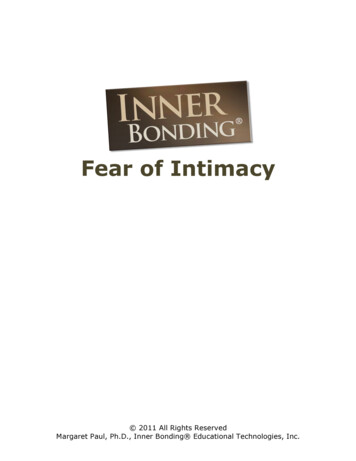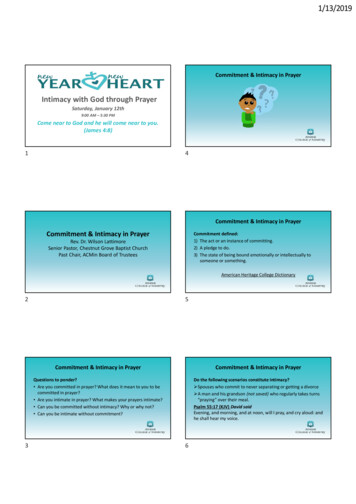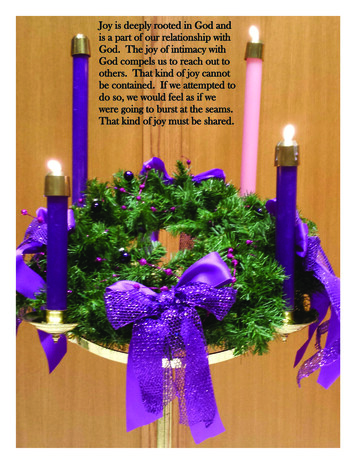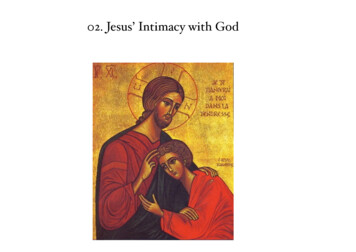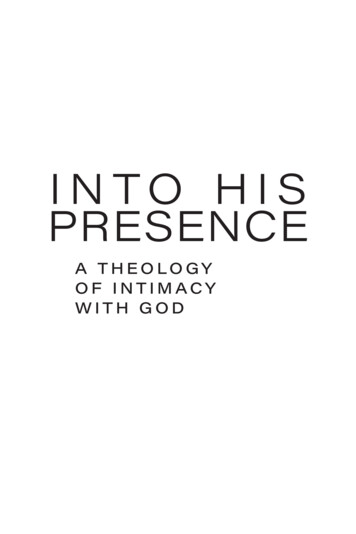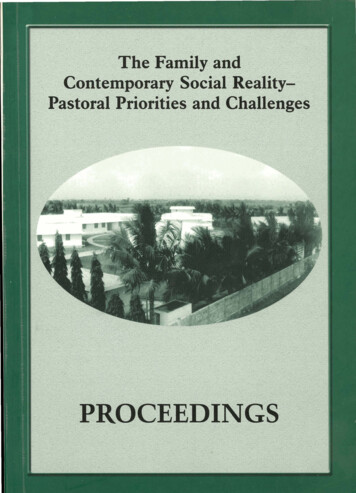
Transcription
-- :A",:;@qpy ,jm?gR- s4ri**E! e33.3. i k -e2.as4;j!&J:da!& 3;F3&The Family andContemporary Social RealityPastoral Priorities and Challenges
CONTENTSIntroductionAcknowledgmentLetter of Appreciation fromThe printing of these Proceedings have been supported byHis Eminence Alfonso Cardinal Lopez TrujilloMissio, Munich - Germany.PART - IInaugurationDr. Catherine Bernard3. Key Note Address-4. Presiding Address-Archbishop Arul Das James1. Welcome Address2. Welcome Address on behalf of CCBIBishop Aloysius D'souzaDr. John J BillingsPART - I1-SEGMENT A-1.On the Way to the Adult Self2. Adult Development and Faith3. Pastoral Care and CounsellingThe Service and Research Foundation of Asia on Family and Culture is a nonGovernmental Organisation with SPECIAL Consultative status to the Economicand Social Council (ECOSOC) of the United Nations.4. Intimacy and Mutuality withGod: Relational PrayerDr. John J SheaDr. John J SheaDr. John J Shea.Dr. Janet K. Ruff ng6. The Self: "All Real Living is Meeting-7. Relatedness Sexuality and Intimacy-Dr. Beverly Ann Musgrave8. Embodied Family Spirituality-Dr. Janet K. Ruffing5 . Sexuality and SpiritualityDr. Janet K. Ruff ngDr. Beverly Ann Musgrave
INTIMACY AND MUTUALITY WITH GOD:RELATIONAL PRAYERJanet Ruffmg, RSM, Ph.D.In the context of the adult self and its development in faith elaborated byDr. Shea, I will focus on relational aspects of Christian prayer and meditation.MY reflections on Christian prayer as it develops in this mode of adult life, sharemany important characteristics for all of us regardless of whether or not we aresingle by choice or by circumstances, married without children, or marriedwith children. Our specific relational and vocational context, however, changeshow and under which conditions we engage in spiritual practices - especiallyin forms of personal and communal prayer which lead to and develop intoVatican Council 11, in its Dogmatic Constitution on the Church (LumenGentiurn) asserted very strongly that all are called to one and the same holinessof life. Christian tradition consistently affirms that this holiness of life consistsof love - love for one another and love for God. Contemplative prayer can beunderstood as the transformative experience of God's love and presence.Prayer is then both presence and relationship. Reflective or meditative forms ofprayer both foster such experiences and prepare for them in addition to thegreat variety of liturgical prayer and devotional life which nurture our spiritualawareness and our developing relationship with God.Prior to Vatican Council 11, many assumed that much of this rich traditionof prayer and contemplation in Catholic life was restricted to clergy or religiouspeople and thus not part of ordinary lay life. Hence the full resources of thetradition were not made available to the People of God. Since Vatican 11, thisPerspective has radically changed. There is a great hunger for the spiritualamong all sectors of the church - for actual, on-going experience of God whichtakes many forms. As charismatic prayer, Scriptural based meditation, simplyreflectingon the Word of God, or more spontaneous colloquial prayer deepensand begins to open u p into periods of silent receptivity to God, experiences offrequently begin to occur. From having heard about God fromelse, Christians experience the mysteries of Christian faith takingplace within their own intimate experience. The Triune God becomes anIntimate familiar entering into a relationship which becomes increasinglyin its texture despite the ontological differences which remain betweenGod and human persons. For us to enter into this loving intimacy with God asrequires both the developmental skills of intimacy and an adult self capable Of relating personally to the unfolding and encompassing mystery of God.
Karl Rahner emphasised the absolulte unity between the love of God andthe Love of neighbur. This was one of the key themes of vatican I1 as well. Atthe deep core of any experience of love, either human o r divine, is a unityamong our loves. We simply cannot really love God without loving all whomGod loves - literally everyone and the creation itself. Conversely, we cannotreally love any other human being authentically without also loving God whoresides at the core of the other. Our particular loves invite us into the deep mystery of God's love disclosing itself in and through out human beloveds. Particular loves when they are not closed in on themselves lead to more universalforms of love.ncompassing love for Christ. When she questioned her deep love for Garciade Toledo, often a source of encouragement to him in his apostolic life, shesays: "I saw Christ with awesome majesty and glory showing great happinessover what was taking place. Thus he told me and wanted me to see clearly thatis always present in conversations like these and how much he is pleased,hen persons so delight in speaking of him." (Life, 34.17). Constance Fitzger-ld, OCD, comments on this passage. "Now her God not only rejoiced in herhuman conversations and loves, but understood her love and concern andfor others as an extension of the love that was flooding her life"/1988,82).Likewise, a focused and intimate experience of God's love for us and ourreciprocation of it, animates us and compels us toward loving the particularpersons who constitute the interpersonal-context of our lives, especially ourfamilies. Within the family, our loving relationships are specific, primary andconstantly changing in relationship to the development of each of the spousesand of the children. Even as adults who may not have joined with another toform our own family, we remain members of our family of origins as siblingsor as adult children. Yet familial relationships do not exhaust our love for others. Families exist within larger networks of extended families and communities which claim their love and care. Each member of the family enjoys anetwork of relationships beyond the circle of the immediate family.Friendship with God is an apt metaphor for developing intimacy with Godnd for the kind of mutuality with God which the mystics describe resultingfrom the transformation of the self through prayer. Friendship is the primaryform of relationship for an adult self in a mutuality of relating. God appears todescribe friendship with us if we are to believe Jesus who says, "I call youaiends," or Aelred of Rievaulx who claims "God is friendship."There is a reciprocal relationship between the style of loving which firstshapes us within our families and influences us in subsequent contexts and ourrelationship with God. We learn the skills and style of relating both within theprocess of prayer and within the process of human interpersonal relating. Whatwe learn in one situation fortunately and unfortunately carries over to the other. Without some experiences of human intimacy and mutuality, it is mostunlikely we will experience intimacy and mutuality with God.Without the divine-human intimacy of contemplative prayer or least someform of solitude, we may be unable to risk being ourselves with others.Recognising that Dr. Musgrave will offer a full psychological developmentof intimacy, the remainder of my remarks describe the growing intimacy withGod that characterises an on-going life of prayer. Teresa of Avila spoke ofprayer as "the intimate sharing between friends." Teresa knew what she Wastalking about. She was a lively conversationalist and enjoyed friends. Becausefriendships of all kinds were an important part of her personality, shelearned to discriminate among those friendships which supported her centralreligious quest and those which frustrated her mystical development. Whenthese loves had become harmonious with one another, she has a lovely visionwhich revealed how she had integrated her deep human loves with her all,Prayer is any activity or passivity which enables relationship with God and ourresponse to that on-going encounter. Prayer is then about presence and aboutrelationship. It is not about making God present; God is already present in usby grace and active in our world. Prayer is the process of opening ourselves tothat presence which creates and transforms us. Thus it can encompass an enormous variety of styles, forms and approaches. Our prayer changes as we changeand as our sense of who God is changes. Spiritual awakening may occur at anydevelopmental stage. It is fairly common for children to have an acute personalawareness of God. In some cultures, this sensitivity to the spiritual dimensionof life is taken for granted. Other cultures deny its possibility. Once spiritualawakening occurs, we choose whether to live in on-going personal relationshipwith God or not. Who God is for us changes as we grow and develop. AlthoughGod remains an incomprehensible mystery, God both fascinates and frightensUS. God has not given us an impossible task of fruitlessly searching in vain, butdraws near to us in invitation and self-disclosure. God entices us but does notus, allures us but does not overpower us.The mystics suggest that the mystery of God expands as one deepens in theSpirituallife. Whatever our entry into initial conscious relationship with this.* Muchof what follow a p p e a din a slightly different from in Living Prayer (March -April 1995)'& refined by Fire", 4-7 and in in formation, "Celibacy and Contemplation'' (May -June 1997)1-2, 10-11,
.,mystery, God will gradually invite US into God's own Trinitarian life so tax-,too, participate in the wholeness and joy of God's own life. As we give ourselves over to God, come to know ourselves and be known by God, we areinhabited by this mystery. God's love and life and joy become our own. We arecaught up into the love which comes from God and returns in God and returnsto God because that love dwells in us.The journey of prayer makes us conscious of this participation in God's lifewhich God is already doing but which requires our consent and participationto complete. Thus, prayer is about presence and relationship, specificsllybecoming aware and present to the mystery we name God, and who has furtherrevealed God's self to us in Jesus. As we grow more deeply into this relation.ship, more aspects of the God mystery encompass us.I believe pastors, teachers of prayer, and catechists can encourage fourbasic dispositions that remain consistently important in our prayer. Here I looknot so much at what happens to us in prayer but rather at what I believe webring to prayer in both good times and challenging ones: intentionality, intimacy, mutuality, surrender and fidelity.INTENTIONALITYFirst of all, prayer is intentional. We attempt to make ourselves available for arelationship with God no other agenda. Intentional prayer differs from othertypes of religious experience which often happens spontaneously outside ofprayer because we have made a choice to open ourselves to God. Psychologically, prayer requires an attitude of openness, availability, a willingness to beinfluenced. We relax a bit from our compulsions, from our need to achieve,from our self-direction. We participate in "shifting gears," in entering anotherstate of consciousness that is closer to simply being and which is closer to ourtrue selves. So we are intentional about being present, about being open andabout wanting to encounter God. Regardless, of what happens in our prayer,consistent choices and practices to open ourselves to God bespeak a desire onour part to move more deeply into the experience of God and to be transformed in our consciousness, our values, our views and our behaviours as aresult of this encounter. It is a choice to spend time in prayer. It is a choice tobe as intentional about this relationship as we are about others. Regardless ofwhether things are going well or poorly, the consistency of our intentionalicYis the least we can do to indicate to ourselves and to God that we care abouthow we are with God. Pragmatically, this intentionality serves as a counter-cultural support, reminding ourselves that we can neither grow in a faith-filledvision of life nor continue to live it without consciously fostering it. fprayeris primarily presence and relationship, it is a time in which we practiceself-intimacy as well as inviting intimacy with God. According to Kay LeighHagan, "intimacy might be defined as the condition of knowing and beingknown at the level of our essential selves . When we drop our masks, we havea feeling of connection, of being truly known. And although most of us wantmore intimacy in our lives, we regard it with profound ambivalence; we feeattracted to and repelled by it at once (1989,6). Intimacy with God is no different. t is often our "out-of-touchness" with ourselves which prevents our intimacy with God. We cannot feel or sense the connection with God because weare either unaware of how we are at this moment or we are afraid to find out.In prayer we bring our developed capacity for intimacy as well as our fear of it.Intimacy requires a mutual vulnerability a n d trust. Dr. Musgrave defines intimacy, in part, as "the process of extending oneself actively in trust to listen toand respond to another, the process of allowing one's inner spirit to betouched by the inner spirit of another." God's Spirit already dwells in us - spiritto spirit. Many of us d o not experience intimacy with God because we d o notreally trust that we can both enjoy God and be safe with God. Until we allowour inner selves to be touched by God, entrusting ourselves to God, we will notexperience this sense of loving presence with God. Whether or not our operative image of God conveys this trustworthiness will greatly affect our ability tobe intimate with God. Not only do we seek to be listened to and responded toby God, so too does God want to be listened to and responded to by us. Thisis a delicate form of spiritual intimacy.Frequently, our intimacy with God cannot deepen until we learn to fear orreject in ourselves as well as deal with whatever is impairing our ability to trustI God. Oneway our intimacy in prayer can stall is our unwillingness to discov'what we do not yet know about ourselves. There is a darkness or sinhlnessithin us which becomes accessible as we simultaneously allow ourselves to be:en and known and loved by God. If we keep the secret of our own darknessom ourselves we cannot ever experience ourselves as fully accepted andlved by God. Our unwillingness to experience this part of ourselves drives us'0 keep God at a distance. Prayer may elude us because we d o not want to bringthis ego-challenged self to prayer.Ann Wilson Schaef(1989, 18-23) identifies four key behaviours which interfere with intimacy. Not taking responsibility, maintaining the illusion ofCOnt"l, being dishonest, and being self-centred. Growth in intimacy with God"quires that we forego all of these behaviours. Intimacy suggests a mutuality.Weour experience of the mystery o r God when we shift our focus fromOur wants and needs to how things are with God. Do we ever ask to share the
activities or experiences of God or Jesus? Or do we keep our focus on what wewant o r think we need? Can we simply allow ourselves to be in the divine presence without demand or need? Dishonesty most frequently happens becauseof a lack of congruence in ourselves. We try to pretend that we are fine whenwe are not. Or we pray for what we think we should pray for even if we donltwant it. Or we are somehow dishonest because we are out of touch with ourselves and don't know it. This is why our prayer often improves when we canhonestly admit to ourselves and to God how we are actually feeling even if wedon't like having those feelings. It places us in a congruent relationship inwhich feelings are free to change or shift because they are owned and present.Difficulty with control is a major obstacle I will discuss under the rubric of surrender. Finally, taking responsibility for our own process and feelings enhances our freedom to be in a relationship because we are not expecting the otherto d o what only we can.Intimacy with God is entirely unique for each one of us. Some of us will findit desirable to express our feelings or present condition directly to God. Thepsalms are wonderful examples of this kind of feeling prayer, from complaintand lament to praise and thanksgiving. Others may not welcome such directexpression of feeling. There are many meditative techniques in which one simply sits and notices what is going on in our consciousness. So instead of directexpression, we might simply notice what is coming up, what preoccupies us,how we are at this moment. Others may prefer an initial period of writingthoughts and feelings addressing oneself more than addressing God and beginning prayer after that, when one is fully present to oneself. Intimacy cannottake place if we are not ourselves, if we are not present to who we are at thismoment as well as willing to be in touch with deeper parts of ourselves that arenot always available in the midst of our hectic daily round. Self-intimacy andintimacy with God eventually lead to the discovery of the true self, the selfbeyond ego and beyond all of our usual descriptors of the self. Augustine saysthat God is "more intimate to me than I am to myself." The depth of the selfwhich comes into the encounter with God is our intima mea, our deepest ormost intimate self. And discovering that intimate self happens in our relationship with God.This intimacy with God is not a one-way sharing. It tends toward n realmutuality with God. God shares God's self intimately with us. It includes notonly how I am but how God wants to be with me. The mystics consistentlydescribe mystical transformation as a real mutuality with God. God wants to beknown and loved by us. To this end God companions us developmentally untilwe acquire the capacity to receive this divine self-disclosure. This is describedby Ignatius of Loyola as "a mutual sharing of goods" and by Catherine of Sienaand Mechtilde as an exchange of love, and God's entrusting to us God's workin the world. The distance between God and human persons is overcome inthis mutuality of relating through divine-human intimacy.**TYPOLOGY OF MEDITATIONA three-fold typology of meditation contributes to our understanding of thev s t array of forms of prayer or meditation which intimacy with God might take.Some of them are standard practices with which we are all familiar. Others areadaptable and can take place in the midst of our daily round without the leisureor freedom from household concerns which have characterised monastic lifein both the East and in the West. Claudio Naranjo (1971) identifies: the negative way, the expressive way, and the way of forms.CLAUD10 NARANJO'S TYPOLOGY OF MEDITATIONPRACTICESTHE NEGATIVE WAY: ELIMINATION,DETACHMENT, EMPTINESS, CENTRED,THE "MIDDLE WAY", MINDFULNESSTHE WAY OF FORMS:THE EXPRESSIVE WAY:CONCENTRATIONABSORPTION, UNION OUTERDIRECTED, TRANSFORMATIONSPONTANEOUS, PROPHETIC, SHAMANISTIC,SURRENDER, VISIONARY, ENTHUSIASTICINNER DIRECTED** See Ruffing (2000) "Mutuality with God:' Where Beloved and Loved OneWholly Flow Through Each other"' in spiritual Direction: Beyond the Beginnings. Mahwah: Pauli57.
The negative way is characterised by emptiness, elimination and detachment. Typically, the meditator focuses o n breath, counts breath, o r sounds amantra, or in Christian tradition the person simply remains in God's presence.The Cure ofArs talked about sitting in the church and looking at Jesus who simply looked back at him. This is a "middle way" between inner directed andouter directed forms.The expressive way is typical of prophetic impulses, shamanistic practicesin which one surrenders to enthusiastic stirrings, enters visionary states. Thisway is "inner directed" meaning that experiences are initiated from within thepractitioner who express internal feelings, impressions, stirrings, and welcomes unconscious content into awareness. Practices might include dancing,artistic expression of every kind, direct expression of emotion in poetry o r conversation, fostering trance states through the use of music and/or rhythmicinstruments, o r simply writing o r paying attention to thoughts, feelings, etcwhile walking or doing some repetitive kind of task. A number of devotionalpractices fit this style as well as pilgrimages and acts of devotion.The third way is the way of forms. This way is characterised by concentration, absorption o r union with an object of deity outside oneself. Hence, it isouter-directed. In these practices the focus is on the other - often through asymbol. Practices such as visualisation exernal or internal is common. Prayingwith scripture in a variety of ways is frequent. Praying with an icon o r sacredimage is also done. Rituals of various kinds, including liturgy frequently haveelements from both the way of forms and the expressive way. According to psychologists individuals tend to prefer one or another of these styles as mosthelpful to them but most people can benefit from adopting practices from theirnon-dominant forms at different times in their livgs. For instance, during transition times in Christian prayer when using scripture may become burdensomeo r simply no longer conveys a sense of God's presence, one of the practices ofthe negative way may help the person remain available to God through a simple breath prayer. If the disturbance in prayer is a result of avoiding some emotion o r situation, an expressive form may release the content and lead to anopen space where God might again be felt.SURRENDERComing into the harmony of our full adult selves with the otherness of Godresults in mutuality and surrender. Surrender is another key disposition in ourselves before God which is implied in both intentionality and intimacy. Surrender is adjustment of the ego to otherness. Intimacy is based on a trust deepenough to enable mutual surrender to one another. It is not a giving over ofthe self but a joining of the selfwith another. It is relinquishing of ego-defencein the favour of becoming a 'we1. This can happen because the adult self canbe in relationship with God without programme's of control o r dishoneswultimately, prayer leads us to union with God which can only occur whenintimacy deepens to the point of surrender, it means the experiencedawareness and yielding to God which acknowledges that God is our happinessand is wholly benevolent toward us - that God is God and we are not yet receiving from God a remarkable empowerment and strengthening of the self. Eachofus goes through a long journey of discovering this. Ego must ultimately surrender its self-interest and control to that which grounds it and gives it being.TO surrender is to be centred on God and not on ourselves. Our intentionality:hoosing to pray includes this willingness eventually to surrender our smallles to the mystery of God. Paradoxically, this becomes not submission tod but a being-together-with God, an amazing partnering to reciprocity in tingand in action in the world. It is mystical. This, of course, is a life-long,cess since the final surrender is the one we make when we die. The mystics- ;gest to us that they have achieved the deepest possible surrender to Godthi:;side of death itself.-.LFIIThe final disposition I want to reflect on is fidelity. Fidelity is not so muchthe regularity with which we pray although it certainly includes that. Rather itis fidelity to the relationship itself. Relationship with God entails more thantime spent in prayer. Fidelity implies being true to ourselves and our deepestdesires. It implies the willingness to take the next step whatever that might beas the mystery of God and the Christ life opens u p within us. Fidelity is our persistence in staying in relationship with God. It means that when we discover weare resisting, avoiding or neglecting this availability to God, we humbly beginagain. Fidelity means being present to God o r at least available with everymajor change in ourselves and our self-understanding. It means giving God thebenefit of the doubt that God is on our side and not against us. If our imagesof God have become inadequate o r if we recognise them to be positivelydestructive, fidelity means we struggle with God in the darkness and inunknowing until a newer or more adequate image emerges. Fidelity meansreturning again and again to God as the source and ground of our lives duringand after every assault o n that belief which occurs throughout our lives.Ministrywhich supports the full development of families in the spiritual dimensionsof their lives includes attention to development of prayer. It is in our fam'lies that we, as children, first glimpse the otherness of God through the bodilySenseof our parents praying. Parents are the first teachers of prayer to their
children. They literally introduce their children to saying prayers, give them,vocabulary for prayer in words, gestures, and practices, and convey to theirchildren our first images of God are parental. However, as we grow and devel.op into adult selves, more than parental or authoritarian images for God areneeded. No image captures the reality of God. God discloses Godself througha wild profusion of images which continually open u p new ways of relating toGod. Ministry to prayer for families means supporting family practices of prayerwith children but also supporting and fostering the adult development of theparents into relational prayer which is open to the unfolding of the mystical.Prayer in this profoundly relational mode is the primary means for cultivating our core relationship with God from which all else flows. This central rela.tionship, the self in God and God in the self, is the religious experience whichenable self-giving parenting and appropriate spousal love. Love begets love.The self which is secure in God's love through intimacy and mutuality is alsoavailable for family, work, friendship, and community.The essence of contemplation is an experience of communion, a to andfrom with God, an experience of the love of God being poured forth into ourhearts. This communion of intimacy and relatedness expands to encompassevery aspect of life, ceasing to be restricted discrete times of personal prayer.As this communion with all that is - an increased capacity to receive and appreciate the Real - manifests itself in every part of our Christian lives, the fruitionof our relationship with God begins to be experienced. No part of life isuntouched by this expanding relationship with the Divine Presence whethersolitude, family activities and care, work, leisure, prayer, relationships o r ministry. The unity of love of God and love of neighbour and the responsive capacity to apprehend reality with increasing clarity and compassion bears fruit inboth the inner circle of familial love and the concentric circles of care and concern which emanate outward from it.WORKS CITEDFitzgerald, OCD, Constance, 1988. "A Discipleship of Equals: Voices from theTradition - Teresa of Avila and John of the Cross." In A Discipleship of Equals:Towards a ChristianFeminist Spirituality, edited by Francis A. Eigo. Villanova,Pennsylvania: Villanova University Press.I e v a u Aelredbof. 1977. Spiritual Friendship. Translated by Mary Eugenia@er. Cisterician Fathers Series Number 5. Kalamazoo: Cistercian Publications.Schaef, Anne Wilson, 1989. "Intimacy and Healthy Relationship Women opower 33: 18-23.Teresa of Avila. 1960. Tbe Life of Teresa of Jesus. Translated and edited by Edlison peers. Garden City, New York: Doubleday.REFLECTION PROCESS1. Take at least - minutes of quiet reflection time. Becall an experience of Goeither during prayer or under other circumstances when you felt God'presence personally. Describe the event and recall your response. Dithese experiences become more frequent or happen not at all, or once otwice? What did God, Jesus, or the Holy Spirit feel like? Does an imagcome to mind that describes the quality of presence o r quality of the relationship?2. As you remember these events or note their absence, what is happening tyou right here and now as you contemplate the possibility of intimacy witGod? Is there any longing or desire for this? Is there any reluctance or feafulness about it? What image of God do you project as you contemplatthis?3. Of the forms of meditationlprayer described by Naranjo, which best facitate our intimacy with God? Do some of the less familiar forms attract yotoward experimentation? Did you recognize that you were already "praing" more than you had realized when you considered these possibilitie4. Of the obstacles to intimacy and mutuality with God, which one(s) affeyou the most? Do you have some way of working with it?Hagan, Kay Leigh. 1989. "Internal Affairs: Journal keeping for Self-intimacy."Women of Power 13:6.5. How does family life foster the development of intimacy with Godprayer as a result of spousal or familial intimacy?Naranjo, Claudio and Robert E. Ornstein. 1971. On the Psychology ofMeditdtion. New York: Viking Press.6. What kind of solitude or aloneness might be part of the regular rhythmsfamily that support self-intimacy as well as intimacy with God?
Friendship with God is an apt metaphor for developing intimacy with God nd for the kind of mutuality with God which the mystics describe resulting from the transformation of the self through prayer. Friendship is the primary form of relationship for an adult self in
